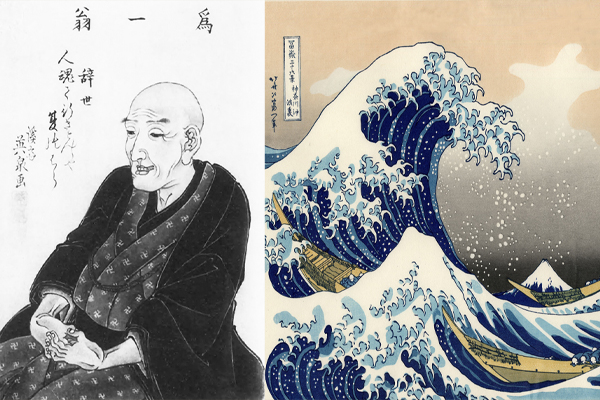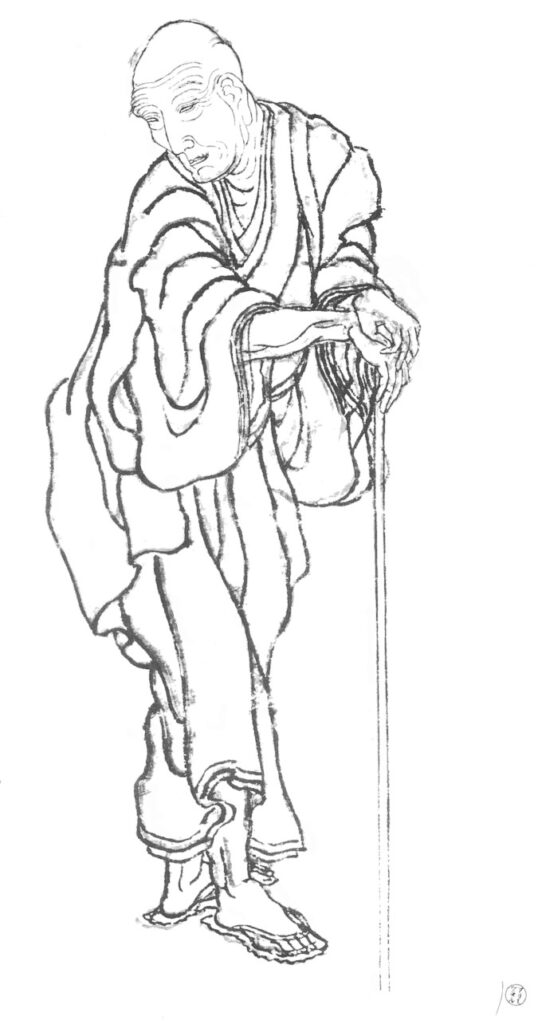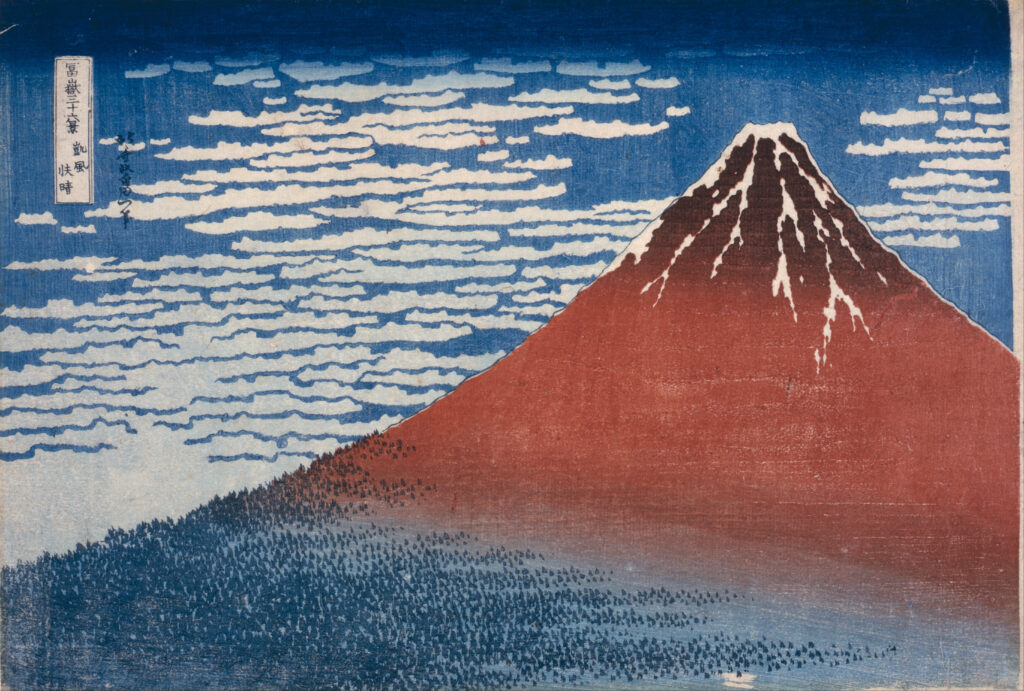

October 31, 1760 – April 18, 1849
葛飾北斎 Hokusai Katsushika
Ukiyo-e Genius Recognized Around the World
Katsushika Hokusai was a prominent Japanese ukiyo-e artist active in the late Edo period. He lived to the age of 90 during the Edo period (1600-1860), a time when the average life expectancy was less than 50 years, and created approximately 30,000 works before his passing. Many of his works, produced over about 70 years, continue to be highly acclaimed even 170 years after his death.
Born in what is now Sumida-Ku, Tokyo, Hokusai was adopted by the artist of bronze mirrors, “Ise Nakajima,” at the age of four. However, he did not pursue the family business. Instead, at the age of 12, he became an underservant in a book-lending shop, where he avidly read many books and taught himself. At 14, he apprenticed himself to a woodblock engraver and learned the art of woodblock prints. However, by the age of 18, he realized that painting was his true passion and decided to pursue a career as a painter.
Ukiyo-e Widely Popular Among the General Public
Ukiyo-e is a genre of painting that emerged at the beginning of the Edo period. Originally, “ukiyo” conveyed a sense of impermanence and suffering, but with the establishment of the Tokugawa shogunate, the city of Edo experienced growth and stability, instilling in people a cheerful zest for life, known as “Uki Uki.” This shift in attitude influenced artists, leading to the development of “ukiyo-e,” a style that positively depicted and reflected people’s everyday lives.
Ukiyo-e can be categorized into two main types: woodblock prints and original paintings, with woodblock prints being more popular among the general public. The price of a ukiyo-e piece was reportedly comparable to that of a bowl of soba noodles at the time, representing a relatively low cost.
Apart from Katsushika Hokusai, other renowned ukiyo-e artists of the era included Utagawa Hiroshige and Kitagawa Utamaro.
An Eccentric Man: Hokusai
Katsushika Hokusai is often described as quite eccentric, with numerous anecdotes highlighting his unconventional nature. One such episode revolves around his frequent relocations. Throughout his life, he moved an astonishing 93 times. The reason for this nomadic lifestyle stemmed from his relentless dedication to his art; he was so engrossed in drawing that he neglected household chores such as cleaning. To him, home served not as a dwelling but as a studio, prompting him to relocate whenever clutter accumulated in his living space. This behavior underscores his single-minded focus on painting, showing little regard for mundane matters like food and clothing.
Another testament to Hokusai’s eccentricity lies in his desire for changing pseudonyms. Over the course of his 70-year career as a painter, he changed his pseudonym 30 times. “Katsushika Hokusai” was just one of many pseudonyms he had; others included “Shunro” during his early years and “Sori” thereafter. This constant reinvention reflects his dynamic personality and perhaps his desire to continually evolve as an artist.

Hokusai’s Masterpiece, “Thirty-six Views of Mt.Fuji”
Among Katsushika Hokusai’s vast body of work, comprising approximately 30,000 pieces, his most renowned creation is “Thirty-six Views of Mt. Fuji.” Executed at the age of 72, this series consists of 46 prints, each depicting Japan’s iconic Mt. Fuji across the four seasons from various vantage points. With his remarkable artistic skill and imaginative concepts, Hokusai vividly portrayed not only the majestic mountain but also the everyday lives of ordinary people. This series has attained such widespread acclaim that its prints are featured in Japanese textbooks, establishing it as a pinnacle of Japanese art.
Three works from the “Thirty-six Views of Mt. Fuji” series stand out as particularly exceptional: “The Great Wave off Kanagawa,” “Clear Day with a Southern Breeze,” and “Thunderstorm Beneath the Summit.” “The Great Wave off Kanagawa” is arguably Hokusai’s most famous piece, renowned for its dynamic composition and meticulous depiction of waves. “Clear Day with a Southern Breeze,” also known as “Red Fuji,” portrays Mt. Fuji bathed in red hues as the sun rises, symbolizing the transition from summer to autumn. “Thunderstorm Beneath the Summit” captures Mt. Fuji under a clear blue sky at its peak, contrasted with dark, lightning-streaked clouds at its base—a testament to Hokusai’s imaginative prowess, as it captures Mt. Fuji from the sky at a time when airplanes did not exist.
Prior to “Thirty-six Views of Mt. Fuji,” the primary focus of Ukiyo-e was on portraits of actors and beauties. Through this groundbreaking series, Hokusai pioneered a new genre within Ukiyo-e: Landscape Pictures.


Hokusai’s Influence On the World
Katsushika Hokusai’s impact extended far beyond the shores of Japan, garnering recognition and admiration worldwide. In 1998, the famous American magazine “LIFE” singled him out as the sole Japanese figure among “The 100 Most Important Events and People of the Past 1000 Years” in its “The Life Millennium” issue.
Hokusai’s name first became known to the world through fragments of “Hokusai Manga,” which were drawn on wrapping paper for Japanese ceramics shipped from Japan to the West. Comprising 15 pieces, the “Hokusai Manga” served as an instructional manual for aspiring artists, capturing the essence of his artistry. It was the French printmaker Félix Bracquemond who stumbled upon these fragments, sparking the phenomenon of Japonism in Europe. The “Hokusai Sketches” swiftly became a bestseller beyond Japan’s borders. Ukiyo-e further made waves at the Paris World Exposition in 1867, where its bold compositions and vibrant colors, previously unseen in European painting, left an indelible mark on European artists, catalyzing the emergence of Impressionism.
Distinguished artists such as Vincent Van Gogh and Edgar Degas found inspiration in Hokusai’s work. Degas, for instance, based his figures on the “Hokusai Sketches.” Henri Rivière drew upon Hokusai’s masterpiece, creating his own woodblock print series titled “Thirty-six Views of the Eiffel Tower,” mirroring the structure of “Thirty-six Views of Mt. Fuji.” Even musicians like Claude Debussy were moved by Hokusai’s art, with Debussy reputedly composing a symphonic poem inspired by “Thirty-six Views of Mt. Fuji, The Great Wave off Kanagawa.”
Thus, Katsushika Hokusai had a great influence on European artists and was very highly regarded. Mastering his favored subjects, he continues to shape the artistic landscape worldwide, leaving an enduring legacy cherished by artists across generations.
.
.
.




